Angela Ackerman's Blog: Writers Helping Writers, page 137
April 2, 2016
Emotional Wounds Thesaurus Entry: Being Raised by Overprotective Parents
When you’re writing a character, it’s important to know why she is the way she is. Knowing her backstory is important to achieving this end, and one of the most impactful pieces of a character’s backstory is her emotional wound. This negative experience from the past is so intense that a character will go to great lengths to avoid experiencing that kind of pain and negative emotion again. As a result, certain behaviors, beliefs, and character traits will emerge.
Characters, like real people, are unique, and will respond to wounding events differently. The vast array of possible emotional wounds combined with each character’s personality gives you many options in terms of how your character will turn out. With the right amount of exploration, you should be able to come up with a character whose past appropriately affects her present, resulting in a realistic character that will ring true with readers. Understanding what wounds a protagonist bears will also help you plot out her arc, creating a compelling journey of change that will satisfy readers.
NOTE: We realize that sometimes a wound we profile may have personal meaning, stirring up the past for some of our readers. It is not our intent to create emotional turmoil. Please know that we research each wounding topic carefully to treat it with the utmost respect.

Courtesy: Randen Pedersen at Creative Commons
Examples: Being raised by parents or caregivers who…
rarely let one experience freedom apart from them
worried constantly about one’s safety
enforced confining rules out of a desire to keep one safe or within their sights (early curfews, approving or denying the child’s choice of friends, not allowing dating, etc.)
discouraged experimentation and taking risks
made all of one’s decisions
constantly hovered
intervened before mistakes could be made, removing the opportunity for one to learn and solve problems
Basic Needs Often Compromised By This Wound: love and belonging, esteem and recognition, self-actualization
False Beliefs That May Be Embraced As a Result of This Wound:
I’m incapable of making my own decisions.
They don’t trust me to do the right thing.
The world is a terrible place where bad things are likely to happen to me.
Being safe is the most important thing.
Mistakes and failure are bad and should be avoided at all costs.
I need someone looking out for me.
Those in authority know what’s best for me and shouldn’t be questioned.
Positive Attributes That May Result: adaptable, cautious, easygoing, innocent, introverted, loyal, obedient, pensive, protective, traditional
Negative Traits That May Result: childish, controlling, cynical, devious, dishonest, evasive, gullible, ignorant, indecisive, inhibited, insecure, irresponsible, lazy, needy, nervous, obsessive, oversensitive, paranoid, pessimistic, possessive, rebellious, resentful, subservient, suspicious, timid, ungrateful, weak-willed, withdrawn
Resulting Fears:
Fear of failure or making mistakes
Fear of risks
Fear of making decisions
Fearing that one is incapable or inept
Fear of the outside world or specific portions of it that one’s parents worried about
Fear of being responsible or in charge
Possible Habits That May Emerge:
Experiencing difficulty making decisions
Relying on others to make important decisions
Blindly trusting those in authority
Rebelling against those who would enforce rules or offer advice
Becoming sneaky or devious as a way of getting around the rules
Avoiding risks; always taking the safest path
Being overprotective of one’s own children
Overcompensating with one’s own children by being overly permissive
Ruling others through fear tactics and manipulation
Doubting one’s abilities and capabilities
Developing mental disorders (panic attacks, phobias, anxiety)
Not learning from one’s mistakes as an adult since one was not able to make and learn from them as a child
Avoiding responsibility
Becoming a follower rather than a leader
TIP: If you need help understanding the impact of these factors, please read our introductory post on the Emotional Wound Thesaurus. For our current list of Emotional Wound Entries, go here.
For other Descriptive Thesaurus Collections, go here.
The post Emotional Wounds Thesaurus Entry: Being Raised by Overprotective Parents appeared first on WRITERS HELPING WRITERS™.
March 28, 2016
Introducing One Stop For Writers’ NEW Structure Tool: Story Maps
It’s been quite a while since Becca and I have posted about One Stop for Writers, a site we launched back in October with Lee Powell, the creator of Scrivener for Windows. And, oh my gosh you guys, I have to tell you that while I love writing books and helping writers through them, this new site, working with Lee and Becca? I am having more fun than I ever have had. It amazes me each and every day how talented these two are, and I am so proud of this site we are creating. It is very exciting to see the One Stop library grow and develop and I feel so lucky to be a part of something that can really change the game for writers.
 Speaking of growing, One Stop For Writers just finished its first upgrade! Honestly, the hardest part was narrowing down what we wanted to tackle first, because we have so many ideas on how to make it even more useful. But somehow we did, and so for those interested, this is what we have added to the site.
Speaking of growing, One Stop For Writers just finished its first upgrade! Honestly, the hardest part was narrowing down what we wanted to tackle first, because we have so many ideas on how to make it even more useful. But somehow we did, and so for those interested, this is what we have added to the site.
Visual Structure Planning: Story Maps
Do the phrases “Story Structure” and “Character Arc” send adrenaline thrumming through your veins, or cause your stomach to drop in free-fall? Either way, it doesn’t matter! Story Maps is a structure-loving writer’s dream AND the answer to a struggling writer’s planning woes.
Most writers would agree that applying structure, either intuitively or through deliberate planning, results in a more powerful story. The problem is there are many types of structure models, and not all look at both inner character development (character arc) as well as the outer story events. Story Maps does both, and so we hope this will make things a bit easier, helping writers visualize as they plan so they know exactly where to go next in their story.

(Click to enlarge)
Adapted from the amazing Hollywood story expert Michael Hauge’s 6-Stage Plot Structure, we lead you through important turning points, providing guidance on outer events and inner character transformation.
The Story Map covers three character arc types: the Change Arc (inner transformation), the Static Arc (action-focus, little growth) and the Failed Arc (a tragedy ending). As you can see below, at each Stage or Turning Point, you can access helpful plotting hints as you plan, and see an example of A Few Good Men broken down by structure points.
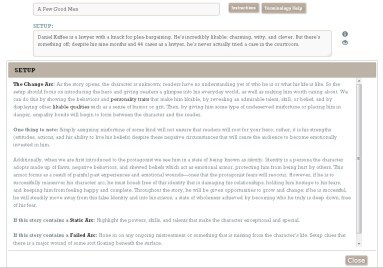
(Click to enlarge)
Once you finish filling in the structure pieces, you can transform your plan into a Map, or download it as a PDF. What could be easier?
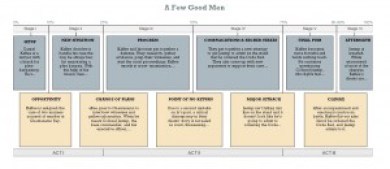
(Click to enlarge)
I know some Pantsers out there are not big fans of structure, but there’s good news on that front, too. In coming weeks we are also bringing on several more tools that allow for timeline and scene planning suitable for different comfort levels of plotting. (I’ll post again when these are on the site, because I can’t wait to show you. Lee and Paul are techno-wizards and what they come up with is pure magic!)
One Stop’s Description Nirvana: The Setting Thesaurus Is Now Bigger & Better
As many of you know, Becca and I have been working on 2 new Setting Thesaurus books which we will release in June. (June! I know, books are a bit slow, aren’t they?) The good news is all the descriptive entries for these Setting books (along with all of our other books & completed thesauruses) are now available through One Stop. Yes, a MASSIVE database of the sights, smells, sounds, tastes and textures for 225 settings at your fingertips as you write!
The Setting Thesaurus spans both urban and rural locations, so you can find everything from an abandoned mine, to a morgue, to a high school hallway, to a nightclub, to a child’s bedroom. We tried to choose real-world locations your characters would be likely to visit, as well as profile places we hope will spark your imagination, helping you to think outside the usual setting box. Hopefully this larger, more robust thesaurus will really help you make their story worlds come alive for readers.
(If you would like to see a example of one of these settings, check out “police car” here.)
So much more is coming, so stay tuned!
No hard sell, just excitement
Probably some would hit you up with the big sell at this point, but that isn’t us. One Stop for Writers might be for you, or it might not be. Either way, it’s all good–just keep writing! 
Thanks for listening as we get all gushy-excited about this new path of ours. Becca and I are having a lot of fun with One Stop, and we hope you are having fun as you write, too. This path we have all chosen can be a tough one some days, so we should embrace joy when it comes and love what we create!
Happy writing,
Angela & Becca
The post Introducing One Stop For Writers’ NEW Structure Tool: Story Maps appeared first on WRITERS HELPING WRITERS™.
March 26, 2016
Emotional Wound Entry: Having Parents Who Favored One Child Over Another
When you’re writing a character, it’s important to know why she is the way she is. Knowing her backstory is important to achieving this end, and one of the most impactful pieces of a character’s backstory is her emotional wound. This negative experience from the past is so intense that a character will go to great lengths to avoid experiencing that kind of pain and negative emotion again. As a result, certain behaviors, beliefs, and character traits will emerge.
 Characters, like real people, are unique, and will respond to wounding events differently. The vast array of possible emotional wounds combined with each character’s personality gives you many options in terms of how your character will turn out. With the right amount of exploration, you should be able to come up with a character whose past appropriately affects her present, resulting in a realistic character that will ring true with readers. Understanding what wounds a protagonist bears will also help you plot out her arc, creating a compelling journey of change that will satisfy readers.
Characters, like real people, are unique, and will respond to wounding events differently. The vast array of possible emotional wounds combined with each character’s personality gives you many options in terms of how your character will turn out. With the right amount of exploration, you should be able to come up with a character whose past appropriately affects her present, resulting in a realistic character that will ring true with readers. Understanding what wounds a protagonist bears will also help you plot out her arc, creating a compelling journey of change that will satisfy readers.
NOTE: We realize that sometimes a wound we profile may have personal meaning, stirring up the past for some of our readers. It is not our intent to create emotional turmoil. Please know that we research each wounding topic carefully to treat it with the utmost respect.
HAVING PARENTS WHO FAVORED ONE CHILD OVER THE OTHER
Examples:
A parent with an obvious “favorite” child
Parents who doted on a child because of a special skill, talent, or quality
Parents who put all their time into one’s child’s interests and hobbies
Blended families where step-siblings are treated differently (taken on special holidays, bought gifts, nicer bedrooms and clothing, etc.)
Parents who have different rules and privileges for one child because of their gender, birth order, etc.
Parents lavishing praise on one for what is merely “expected” of the other (good grades, accolades, milestones, etc.)
A parent being more affectionate with one child while harder on another
Parents who bond more with one child (show affection, spend time together, communicate) because of their pleasant disposition
Parents who cater to one child because of an illness or condition
Parents who push one child harder because they show promise (to incentivize success) or because they have behavior issues (tough love)
Basic Needs Often Compromised By This Wound: physiological needs, love and belonging, esteem and recognition, self-actualization
False Beliefs That May Be Embraced As a Result of This Wound:
I’ll never be as good as my sibling, so why try?
I can never do anything right, and my sibling can do no wrong
If I try harder to be good, maybe they will love me as much as they do him
Dad (or Mom) loves the new family more than the old one
I will never measure up, no matter how I try
There must be something wrong with me
I can’t please them, everything I do isn’t good enough
Being alone is better than being with a family that doesn’t want me in it
Positive Attributes That May Result: Ambitious, appreciative, cooperative, diplomatic, empathetic, generous, honorable, humble, independent, introverted, just, kind, mature, nurturing, pensive, perceptive, persistent, private, proper, responsible, sentimental, supportive, wise
Negative Traits That May Result: Addictive, catty, childish, confrontational, cynical, defensive, disloyal, disrespectful,impulsive, indecisive, inhibited, insecure, irresponsible, jealous, judgmental, manipulative, needy, perfectionist, possessive, rebellious, reckless, rowdy, self-destructive, stubborn, subservient, timid, vindictive, withdrawn, workaholic
Resulting Fears:
Fear of rejection
Fear of competition
Fear of being one-upped by others, outperformed
Fear of disappointing others
Fear of vulnerability
Fear of loving as it may be withdrawn
Fear of failure
Possible Habits That May Emerge:
Avoiding one’s family as an adult
Becoming subservient as an adult to aging parents in hopes of being seen in a new light
Strained relationships between siblings
Seeing everything as a competition
Difficulty with teamwork and team-building; wanting to work alone
Becoming the person one’s parents want, not who one wishes to be
People-pleasing behavior, doing thing for praise
Behavioral issues, seeking negative attention when positive attention is denied
Going above and beyond in relationships
Parenting one’s own children, obsessively making sure everything is fair
Showing love and affection, telling people what they mean to oneself
Always comparing oneself and one’s siblings in every regard
One’s sibling’s name becoming a trigger for anger or frustration
Even as an adult, struggling to be happy for one’s sibling when something good happens for them
TIP: If you need help understanding the impact of these factors, please read our introductory post on the Emotional Wound Thesaurus. For our current list of Emotional Wound Entries, go here.
For other Descriptive Thesaurus Collections, go here.
Image: Pixabay @ Marcisim
The post Emotional Wound Entry: Having Parents Who Favored One Child Over Another appeared first on WRITERS HELPING WRITERS™.
March 22, 2016
35 Posts To Help Writers Elevate Their Craft And Marketing Skills
 A friend of mine asked me for a list of posts that I would like shared online (how nice, right?) and it prompted me to visit my website stats to see what posts were the most popular with those who visit.
A friend of mine asked me for a list of posts that I would like shared online (how nice, right?) and it prompted me to visit my website stats to see what posts were the most popular with those who visit.
This in turn led to the bright idea that instead of just sending her the list, I should share it here, too!
If you are looking for helpful posts in different areas of writing and marketing, these TOP 5 LISTS are ones visitors seem to enjoy the most. If you find any of them especially helpful, feel free to pass them on to others, too. 
CHARACTERS
The Four Types of Character Flaws
Personality Traits: Building a Balanced Character
Lessons From James Scott Bell: Characters That Jump Off The Page
Finding Your Character’s Weakness
The Subtle Knife: Writing Characters Readers Trust But Shouldn’t
EMOTIONS
Hidden Emotions: How To Tell Readers What Characters Don’t Want To Show
Writing Emotion: Does Your Hero Shrug, Smile & Frown Too Much?
Writing Extreme Emotion Without The Melodrama
Show, Don’t Tell: Revealing True Emotion In Dialogue
3 Steps to Taking Your Character Further and Deeper With…Anger?
EMOTIONAL WOUNDS
Understanding Character Wounds: A List Of Common Themes
How To Uncover Your Character’s Emotional Wound
Why Is Your Character’s Emotional Wound So Important?
How Your Hero’s Past Pain Will Determine His Character Flaws
CHARACTER ARC (MOTIVATION, GOALS, GROWTH)
Planning a Novel: Character Arc In A Nutshell
5 Surprising Ways Regret Can Deepen Your Hero’s Arc
The Importance of Psychological Development in Character Growth
How Your Character’s Failures Can Map A Route To Self-Growth
The Connection Between Emotional Wounds and Basic Needs
STRUCTURE & TECHNIQUE
Writing Patterns Into Fiction: Scene and Sequel
Story Midpoint & Mirror Moment: Using Heroes’ Emotions To Transform Them
James Scott Bell: The “Write From The Middle” Method
5 Important Ways to Use Symbolism in Your Story
Inside One Stop For Writers: Unique Templates & Worksheets
MARKETING
A Book Marketing Truth Few Experts Will Admit
5 Steps To Find Your Book’s Ideal Audience
Creative Book Launches That Command Attention
Need Online Exposure? Asking Bloggers For Help
OUR TOP POSTS LOCATED ON OTHER BLOGS
How To Research Your Book Smarter, Instead of Harder
Eight Ways To Make Your Character More Plausible
The 7-Step Business Plan For Writers
Flaws, Emotional Trauma & The Character’s Wound
Brainstorming The Hero Before You Start Writing
Hopefully there are a few post here that catch your eye and can help you with whatever you are currently wrestling with.
And what is the #1 visited page on our site?
There’s a reason for it too…if you haven’t visited, I recommend you do. There are many free tools and handouts that have been downloaded well over 50,000 times.
Happy writing, all!
Image: carloscuellito87 @ Pixabay
The post 35 Posts To Help Writers Elevate Their Craft And Marketing Skills appeared first on WRITERS HELPING WRITERS™.
March 19, 2016
Emotional Wound Entry: Being Fired or Laid Off
When you’re writing a character, it’s important to know why she is the way she is. Knowing her backstory is important to achieving this end, and one of the most impactful pieces of a character’s backstory is her emotional wound. This negative experience from the past is so intense that a character will go to great lengths to avoid experiencing that kind of pain and negative emotion again. As a result, certain behaviors, beliefs, and character traits will emerge.
 Characters, like real people, are unique, and will respond to wounding events differently. The vast array of possible emotional wounds combined with each character’s personality gives you many options in terms of how your character will turn out. With the right amount of exploration, you should be able to come up with a character whose past appropriately affects her present, resulting in a realistic character that will ring true with readers. Understanding what wounds a protagonist bears will also help you plot out her arc, creating a compelling journey of change that will satisfy readers.
Characters, like real people, are unique, and will respond to wounding events differently. The vast array of possible emotional wounds combined with each character’s personality gives you many options in terms of how your character will turn out. With the right amount of exploration, you should be able to come up with a character whose past appropriately affects her present, resulting in a realistic character that will ring true with readers. Understanding what wounds a protagonist bears will also help you plot out her arc, creating a compelling journey of change that will satisfy readers.
NOTE: We realize that sometimes a wound we profile may have personal meaning, stirring up the past for some of our readers. It is not our intent to create emotional turmoil. Please know that we research each wounding topic carefully to treat it with the utmost respect.
BEING FIRED OR LAID OFF
Examples:
Being fired for poor performance
Being laid off because one’s department has downsized or one’s position has been outsourced
An infraction being used as the excuse for a firing when one’s employers have been looking for an excuse to let one go for other reasons (personality conflicts, unethical company practices, etc.)
Losing one’s job at a critical time (baby on the way, just married, just bought a home, etc.)
Being let go because one is a financial drain (medical issues, needing time off, etc.) and so when an opportunity to let one go “legally” comes up, the company takes it
Being a strong performer but a company takeover leads to a change of management as the employees of one side of the merger are let go
Basic Needs Often Compromised By This Wound: physiological needs, safety and security, love and belonging, esteem and recognition, self-actualization
False Beliefs That May Be Embraced As a Result of This Wound:
I have to always work harder than everyone else if I want to stay employed
I have to prove I am a team player even if I don’t agree with the company is doing or I’ll lose everything
I was a fool to try and have a career in this area; I’m not good enough
I am worthless if I can’t support my family
If I try to get back into that line of work, I’ll be fired again
I shouldn’t extend myself (by buying a house, setting down in a neighborhood, purchasing a car, enjoying holidays, etc.) because no job is stable
People will lose respect for me if I can’t stay employed
Without my work, I’m nothing, so I’ll do whatever it takes
My spouse will leave me if I can’t support my family
Positive Attributes That May Result: cooperative, courteous, efficient, empathetic, focused, honorable, industrious, loyal, mature, merciful, obedient, organized, perceptive, persistent, philosophical, proactive, professional, resourceful, sensible, supportive, thrifty
Negative Traits That May Result: addictive, childish, confrontational, controlling, defensive, fanatical, hostile, humorless, insecure, know-it-all, nervous, obsessive, perfectionist, resentful, self-destructive, self-indulgent, stingy, unethical, weak-willed, workaholic, worrywart
Resulting Fears:
Fear of taking risks (especially financial)
Fear of saying or doing the wrong thing at work
Fear of under performing or disappointing one’s employers
Fear of abandonment (one’s spouse leaving, etc.)
Fear of competition
Fear of change
Fear of debt
Possible Habits That May Emerge:
Lying to family when asked about work when things aren’t going well
Hiding difficulties from employers (an illness, struggling with the workload, etc.)
Watching one’s finances carefully and being uncomfortable with big expenses
Tying one’s level of job security & employer satisfaction to self worth
Working late and going the extra mile to look good
Ignoring ethical issues at work in favor of proving one is a good employee
Always being worried about money
Needing constant reassurance that one is doing a good job at work
Taking on extra shifts or working on vacation to get ahead
Taking a second job to be able to put more money away, just in case
Bringing work home, having a poor work-life balance
Missing out on family time for work
Company loyalty to one’s current job
Being unwilling to move on from a job one dislikes because it pays the bills and is “safe”
Feeling guilty if one has idle time (especially at work)
TIP: If you need help understanding the impact of these factors, please read our introductory post on the Emotional Wound Thesaurus. For our current list of Emotional Wound Entries, go here.
For other Descriptive Thesaurus Collections, go here.
Image: Level 17 @ Pixabay
PSST!
I am also over at Writers In the Storm looking at how To Create Deeper Emotional Connections with Readers, so please stop in if you like. 
The post Emotional Wound Entry: Being Fired or Laid Off appeared first on WRITERS HELPING WRITERS™.
March 15, 2016
Purging the Fear

Courtesy: Creative Commons
Writers experience a ridiculous range of emotions throughout the writing process: excitement when a new idea comes along; satisfaction and joy when a work-in-progress is completed; and fear at varying intervals between.
Sadly, for every person reading this post, fear (at some level) is an issue that must be addressed. It stifles creativity, encourages negativity, and exponentially increases our chances of failure. It’s a toxin that poisons us on a basic, human level. And it’s death to the writing process.
I’ve struggled a bit with fear on a personal level—fighting and eventually overcoming a panic disorder after the birth of my first child. Being a slow learner, it took me years to realize that the techniques I had applied to address personal fears could also be used to manage the fears in my writing life. Since this is something that all of us deal with, and because I love the idea of turning our demons into forces of good, I’d like to share what I’ve learned about managing fear when it comes to writing. When you find yourself getting stuck, avoiding a scene or project, or fearing a part of the process, try these steps:
Examine the problematic area so you can identify and name the fear. I took a long writing break when my kids were born. The itch to write never quite went away, but for various reasons, I just couldn’t get back into writing fiction. After some serious scrutiny, I realized that I was terrified to write a novel again after taking such a long break. And trying to do it with preschoolers…Oy. I was convinced that I wouldn’t be able to do it. Identifying exactly what was holding me back enabled me to look at the problem head-on and come up with a plan of attack.
If your fear is based on a lie (as many fears are), replace the lie with truth. Once I named it, I could see that my fear—that I couldn’t write a novel with small children underfoot—was irrational. Writers do it all the time. Personal writer friends of mine were doing it at the exact time that I was struggling. But by subconsciously believing the lie and repeating it to myself whenever I considered starting a new fiction project, I was giving strength to it and further ingraining it into my brain. So I replaced the lie with truth. Instead of telling myself that I needed to wait, I claimed that I could write a novel right now, in this current stage of life. Pretty soon I started to believe it, and my fear diminished.
This isn’t to say that all of our fears are irrational. As our natural response to real or perceived threats, fear has a clear purpose and is oftentimes necessary. Examine your fear realistically to determine whether it should be heeded or reeducated.
Make a plan and take steps. Fear is almost always tied to goals and failures. This story is too complicated for me to write; I can’t figure out this plot issue; I’ll never be a successful author. In essence, we want to accomplish something, but we’re afraid to fail. To combat this, identify the goal associated with your fear, then make it manageable. In my situation, I had to look at my life as a mother of preschoolers and figure out how much time I could realistically devote to writing. The plan I came up with was one that would take a lot longer than it used to, back when I didn’t have kids and worked part time. But it’s totally doable. As Antoine de Saint-Exupéry once said: a goal without a plan is just a wish. Turn your fear into a manageable goal. Look at it realistically, and you’ll most likely find that, with a little tweaking, success is attainable.
One caveat to all this: fear isn’t always the culprit. Many other thieves can steal our creativity and effectiveness: unforeseen circumstances, events that bring on strong and overwhelming emotions (grief, exhaustion, depression, etc.), and the busyness of life in general can all stymie productivity. Sometimes, we simply need to take a break from writing so we can deal with life. Sometimes we need to cry or smack a couple hundred softballs or take a really long drive. But if you’re stuck due to fear, give these tips a try. Hopefully, they’ll start you on the path to managing your fears and achieving your goals in the new year.
So, to recap:
Examine yourself as a writer to uncover potential fears. In what area are you holding back? Is there an opportunity for growth (employing a new marketing strategy, writing in a different genre, exploring a difficult area of writing craft) that you’ve been avoiding or are too afraid to try?
Name the fear. What fear is at the root of your avoidance? If your fear is based on a lie, summarize the lie in its most succinct form. (I don’t have time to write a book right now. I suck at characterization. I’ll never be able to reach my audience.)
Replace the lie with a simple truth. (I can make time to write a book. I can improve at characterization. I will learn to reach my audience.) When you find yourself returning to your old, fearful thought patterns, refute the lies by vocalizing the truth.
Fashion a plan to achieve your goal. Include steps that are specific and manageable. Assigning time frames for each step is a great way to keep yourself on track.
The post Purging the Fear appeared first on WRITERS HELPING WRITERS™.
March 12, 2016
Emotional Wound Entry: Being Publicly Humiliated
When you’re writing a character, it’s important to know why she is the way she is. Knowing her backstory is important to achieving this end, and one of the most impactful pieces of a character’s backstory is her emotional wound. This negative experience from the past is so intense that a character will go to great lengths to avoid experiencing that kind of pain and negative emotion again. As a result, certain behaviors, beliefs, and character traits will emerge.
 Characters, like real people, are unique, and will respond to wounding events differently. The vast array of possible emotional wounds combined with each character’s personality gives you many options in terms of how your character will turn out. With the right amount of exploration, you should be able to come up with a character whose past appropriately affects her present, resulting in a realistic character that will ring true with readers. Understanding what wounds a protagonist bears will also help you plot out her arc, creating a compelling journey of change that will satisfy readers.
Characters, like real people, are unique, and will respond to wounding events differently. The vast array of possible emotional wounds combined with each character’s personality gives you many options in terms of how your character will turn out. With the right amount of exploration, you should be able to come up with a character whose past appropriately affects her present, resulting in a realistic character that will ring true with readers. Understanding what wounds a protagonist bears will also help you plot out her arc, creating a compelling journey of change that will satisfy readers.
NOTE: We realize that sometimes a wound we profile may have personal meaning, stirring up the past for some of our readers. It is not our intent to create emotional turmoil. Please know that we research each wounding topic carefully to treat it with the utmost respect.
BEING PUBLICLY HUMILIATED
Examples:
A teacher making an example of a student in front of others (shaming them for poor performance, dress code, attitude, etc.)
Having one’s reputation damaged (sex videos surfacing, one’s unfiltered thoughts being taped without one’s knowledge and then aired, etc.)
A shameful secret, closely guarded, being shared to one’s peers or the public (if one is well-known)
A messy job firing that is not handled with respect or dignity
Being falsely accused of a terrible or taboo crime (swindling seniors, sex with a minor, animal abuse, murder, etc.)
Being hazed or pranked in a humiliating way in a way that everyone knows about it (a video on you tube, gossip, etc.)
One’s infidelity being known by all when a vengeful spouse defaces one’s property with the words “cheater” or worse
Vicious rumors (or truth!) being shared that causes shame and embarrassment (an unusual sexual preference, mistreatment accusations, etc.)
An office romance becoming public in a very embarrassing way (caught on camera, a private email accidentally being forwarded or shared through the company, being walked in on)
A wardrobe malfunction on stage, on air, at school, or in a place where one was seen by many (a kiss cam at a baseball game, for example)
A rival smearing one’s reputation and bringing embarrassing secrets into the limelight to discredit (like political rival)
Passing out naked or semi-naked in a public place
Basic Needs Often Compromised By This Wound: safety and security, love and belonging, esteem and recognition, self-actualization
False Beliefs That May Be Embraced As a Result of This Wound:
It doesn’t matter what I do, people will never forget what happened
I will never be able to achieve my dreams because everyone will remember what I did
It doesn’t matter that I’m innocent; people will always wonder about me anyway
I have to move away, change my name. I can’t move past this here.
If anyone finds out about my past, my life will be over
All people are the same: rotten inside. They get off when someone is dragged down
I don’t deserve happiness after what I did
I can’t ever show my face again, my career is over (if one has a highly visible career or is a household name)
Positive Attributes That May Result: cautious, courageous, discreet, honest, honorable, inspirational, merciful, objective, persuasive, private, proactive, protective, resourceful, sensible, tolerant, uninhibited
Negative Traits That May Result: addictive, confrontational, cowardly, defensive, dishonest, foolish, gullible, impulsive, inhibited, insecure, macho, martyr, melodramatic, paranoid, resentful, self-destructive, suspicious, timid, withdrawn
Resulting Fears:
Fear of being recorded (photos, video, vines, snap chat, audio, etc.)
Fear of being on stage, on display, or otherwise having attention drawn to oneself
Fear of being exploited
Fear of trusting the wrong person
Fear of public opinion or the gossip wheel
Possible Habits That May Emerge:
Choosing to stay home rather than go out
Tightening one’s friendship group to only a few trusted people
Avoiding social media, and closing one’s accounts
Feeling anxiety when the phone or doorbell rings, or when email alerts come in
Looking around when out and about, feeling watched
Trying to change one’s appearance in hopes it will help one fade out of the public eye
Not returning to the place where the humiliation took place (quitting the job, changing schools, leaving politics or the limelight, etc.
Googling one’s name to see if others are still obsessed with what happened
Mistrusting new people or questioning their motives, not taking them at their word
Not taking care of oneself as well (out of shame, humiliation, depression, etc.)
Becoming sensitive to situations that mirror one’s own (jokes, TV shows that make light of a similar circumstance, something a friend says in jest, not thinking how it will be taken, etc.)
Being afraid to go out, worrying one will be recognized
Feeling that people around oneself are in judgement mode all the time
TIP: If you need help understanding the impact of these factors, please read our introductory post on the Emotional Wound Thesaurus. For our current list of Emotional Wound Entries, go here.
For other Descriptive Thesaurus Collections, go here.
Image: sevenheads @ Pixabay
The post Emotional Wound Entry: Being Publicly Humiliated appeared first on WRITERS HELPING WRITERS™.
March 8, 2016
As A Writer in Today’s World, What Do You Need?
I was tooling through some of our older posts here at Writers Helping Writers, and I found a “how are we doing?” one from The Bookshelf Muse era. This is where we would do a check in with you guys and make sure we’re not totally screwing this whole blogging thing up. 
Seeing it reminded me that it’s been a long time since I checked in, so that’s what I’m doing today. But this time, I’m not just asking how we’re doing, and if we’re meeting your needs, but also asking…
What Do You Need?

Being a writer is so much more than pounding out a book, isn’t it?
As writers, we need a lot of things to succeed…support. Time to write. Knowledge, gosh…SO MUCH knowledge. Oceans of it, about everything–writing, marketing, publishing and so much more.
(And hey, a bit of luck would be nice too.)
Unfortunately with Becca and I being on this side of the computer, and you guys on that side, we can’t come do that pile of laundry that’s eating the top of your washing machine, or watch your kids so you can write (and frankly, I don’t know that you want me looking after your kids, mwah-ha-ha), but…we do have ears. We’re listening.
And while Becca and I have still so much to learn, in the last few years, we’ve also acquired some potentially useful experience. Maybe some of it can help you.
We’ve written and self-published three books that went on to sell around 150,000 copies combined. Now we didn’t do this through ads, or by using Kindle Unlimited, or offering free downloads or using services like BookBub, so we don’t have experience with those things. But, we’re happy to talk about what we did do, and what worked/what didn’t.
We’ve negotiated foreign right deals via agents and sub agents for all our books, print and digital, so we understand that process. And we can share what we looked for in a foreign rights agent, and what a typical FR deal might look like.
Knowing exactly zero about blogging, we started a blog. It’s now past 4 million hits, believe it or not (and thanks for that, cause that’s all you!) So our trial-by-fire knowledge is yours for the taking.
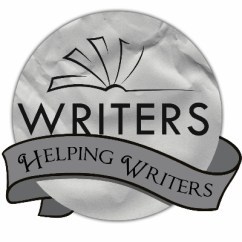
Writers Helping Writers™ is who we are, so why not make it official?
We’ve started several businesses in this time, and so have worked with lawyers to hammer out operation agreements and set up banking and accounting for each. We’ve re-branded ourselves and then trademarked that brand. We’ve created non-book products and copyrighted those products. We’ve dealt with copyright infringement and had books removed from Amazon as a result. And, one thing that comes with having an original idea as we did is the rise of fast followers (copycats). Struggling to stay ahead of those is very hard, but part of the business. I know this stuff isn’t the sexy side of writing, but it is necessary to understand it if you want this as a career. Becca and I also have the added challenge of being co-authors in different countries. We’re happy to shed light on any part of the business end of being an author.
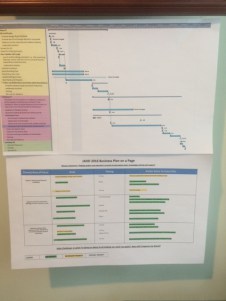
This is our life now, LOL
To help with the last point, we learned how to create and follow a business plan to help us prioritize better and and manage our time, without which we would never be able to manage all the spinning plates. Becca and I have only met twice in real life, so learning how to work with someone remotely, divvy up work and respect one’s another’s expertise really plays into what we do. And now of course we have One Stop For Writers and another partner, Lee Powell, which means more teamwork and honing that skill set.
We’ve had to figure out how to market ourselves in a world that hates promotion, and use social media the right way (when like most writers, we didn’t quite get social media at first!) But, we’ve discovered how to do it and stay true to who we are, building relationships and creating a true community spirit among our readers.
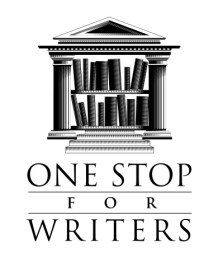
The effort that went into this logo…holy cow. We learned that so many of the things that seem like they aren’t a lot of work…are.
Speaking of Lee, Becca and I can also add web-based software to the list of strange things we now have experience in. Building and then running a site is no easy task and has a learning curve, but again, happy to talk about this if branching away from books is something you guys are considering for yourself. One Stop also made it necessary for me to start an online platform from scratch, and so I’ve learned a lot about social media all over again as someone “new” to it, as One Stop is only 5 months old.
Assessing opportunities is another thing Becca and I have gotten better at, simply because as you network and your career grows, more opportunities come your way. And like publishing contracts, or visibility opportunities, some of what comes may be great, but other things are not. Sometimes an opportunity will come along that is completely off-beat, taking your in a different direction, and so you really have to decide if the time and energy it will take is worth deviating from your current plan. There’s only one of you, and so you have to make good decisions about where your time goes. Learning how to sort good opportunities from flat ones is a necessary skill set for all authors.
Well, that’s pretty much a snapshot of our last four years.  Becca and I are still learning so much each day, and we’re stretching ourselves daily to do better. To reach the next step. And like anyone, as we grow, we pick up tidbits of knowledge. So if something we have dealt with is something can now help you, let us know!
Becca and I are still learning so much each day, and we’re stretching ourselves daily to do better. To reach the next step. And like anyone, as we grow, we pick up tidbits of knowledge. So if something we have dealt with is something can now help you, let us know!
Being a writer means taking steps, one after the other, to get closer to our goals. Can we help you get to the next one?
Feel free to use the comments to tell us what is on your mind, what is weighing you down, what you are struggling with. Tell us what is making you feel like you can’t get ahead. And then please, tell us what you need. We’re by no means experts, but if we can, we’ll try to help. We know a lot of good places to go for information, and can maybe point you in the right direction for certain things.
And while we’re at it, let us know what you’d like to see blogged about. Or what new Thesaurus Collections you’d like us to explore, or even what book you would like to see us write next. We’re always interested in your ideas!
Image 1: Public Domain Pictures @ Pixabay
Image 5: Peggy_Marco @ Pixabay
The post As A Writer in Today’s World, What Do You Need? appeared first on WRITERS HELPING WRITERS™.
March 5, 2016
Emotional Wound Entry: Telling The Truth But Not Being Believed
When you’re writing a character, it’s important to know why she is the way she is. Knowing her backstory is important to achieving this end, and one of the most impactful pieces of a character’s backstory is her emotional wound. This negative experience from the past is so intense that a character will go to great lengths to avoid experiencing that kind of pain and negative emotion again. As a result, certain behaviors, beliefs, and character traits will emerge.
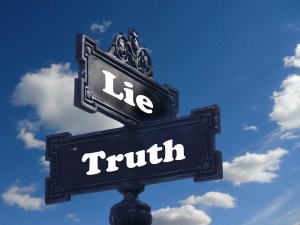 Characters, like real people, are unique, and will respond to wounding events differently. The vast array of possible emotional wounds combined with each character’s personality gives you many options in terms of how your character will turn out. With the right amount of exploration, you should be able to come up with a character whose past appropriately affects her present, resulting in a realistic character that will ring true with readers. Understanding what wounds a protagonist bears will also help you plot out her arc, creating a compelling journey of change that will satisfy readers.
Characters, like real people, are unique, and will respond to wounding events differently. The vast array of possible emotional wounds combined with each character’s personality gives you many options in terms of how your character will turn out. With the right amount of exploration, you should be able to come up with a character whose past appropriately affects her present, resulting in a realistic character that will ring true with readers. Understanding what wounds a protagonist bears will also help you plot out her arc, creating a compelling journey of change that will satisfy readers.
NOTE: We realize that sometimes a wound we profile may have personal meaning, stirring up the past for some of our readers. It is not our intent to create emotional turmoil. Please know that we research each wounding topic carefully to treat it with the utmost respect.
TELLING THE TRUTH AND NOT BEING BELIEVED
Examples:
Telling someone one trusts that one is being abused by a close relative (parent, sibling, uncle, etc.) and not being believed
Going to the police and reporting a crime (a rape or physical assault, for example) and not being believed
Being accused of something (stealing, lying, etc.) and proclaiming one’s innocence has no effect
Being charged with a crime one did not commit
Being sentenced and punished for a crime one did not commit
Having a parent believe someone else over their own child’s accounts of what happened
Being called a liar repeatedly by one’s parents, caregivers or those in authority
Confiding in a teacher or principal about an abusive situation and being labelled a troublemaker
Giving a witness account of something and it being dismissed as lies
Giving an account of something that challenges belief systems and being made fun of for it (seeing a ghost, talking to God, spotting a UFO, experiencing something supernatural, etc.)
Basic Needs Often Compromised By This Wound: physiological needs, safety and security, love and belonging, esteem and recognition, self-actualization
False Beliefs That May Be Embraced As a Result of This Wound:
Why tell the truth? No one will believe it
If I tell, I’ll just get in trouble
If I tell the truth, people will just hate me or blame me
People say honesty is the best policy but it isn’t
People only believe what they want to hear
I can’t count on anyone to stand beside me when it matters most
People think everything I say is a lie anyway, so I may as well lie and come out ahead
The people you think love you will betray you in the end
The only one who looks out for me is me
Positive Attributes That May Result: cautious, courageous, disciplined, empathetic, honest, honorable, independent, just, loyal, meticulous, nurturing, persistent, persuasive, protective, responsible, socially aware, spiritual, wise
Negative Traits That May Result: antisocial, compulsive, cynical, defensive, dishonest, disloyal, evasive, fanatical, hostile, inhibited, insecure, judgmental, know-it-all, needy, nervous, obsessive, oversensitive, paranoid, perfectionist, prejudiced, pessimistic, rebellious, resentful, timid, uncommunicative, weak-willed, withdrawn
Resulting Fears:
Fear of not being believed
Fear of persecution
Fear of being wrong about something and being accused of misleading others
Fear of rejection
Fear of being taken advantage of
Fear of trusting the wrong person and being betrayed
Fear of vulnerability
Fear of those with power or authority who can twist the truth to be whatever they say it is
Possible Habits That May Emerge:
Developing a compulsion for honesty (being overly honest)
Feeling one must prove that one is honest
Asking for assurances that one is believed
Explaining oneself and one’s motivations when it isn’t asked for or necessary
Growing explosively angry when one is not believed
Suffering a complete meltdown when one is challenged regarding the truth
Lying compulsively to mask feelings and avoid being hurt by others
Not being able to take a joke about lying or dealing poorly with being teased
Proving one’s loyalty at every opportunity
Being unable to keep a secret if by doing so one feels one is lying to others
A compulsion to reveal the truth to others if they are being mislead by someone else
Not opening up or sharing one’s past experiences because one expects to not be believed
Telling people what they want to hear to avoid problems
Obsessing over the truth, and over-detailing answers to prove one is being truthful
Never making assumptions and always searching for facts
Resenting those who are skilled liars when others take them at their word
A highly-tuned sense of fairness
TIP: If you need help understanding the impact of these factors, please read our introductory post on the Emotional Wound Thesaurus. For our current list of Emotional Wound Entries, go here.
For other Descriptive Thesaurus Collections, go here.
The post Emotional Wound Entry: Telling The Truth But Not Being Believed appeared first on WRITERS HELPING WRITERS™.
March 2, 2016
How Your Character’s Failures Can Map A Route To Self-Growth
So, failure. Ugh, right?
 Well, I was feeling like a failure today, like I’d let the team down because an idea of mine went sour. It sucks when that happens, but that’s how it goes sometimes. I found myself retracing my steps, looking at how I got from A to B to C, to what I should have thought of to avoid where things ended up. It comes down to a lack of knowledge, and I’ve learned from it. This led me to think a bit more about failure, and our characters.
Well, I was feeling like a failure today, like I’d let the team down because an idea of mine went sour. It sucks when that happens, but that’s how it goes sometimes. I found myself retracing my steps, looking at how I got from A to B to C, to what I should have thought of to avoid where things ended up. It comes down to a lack of knowledge, and I’ve learned from it. This led me to think a bit more about failure, and our characters.
Failure is something no one looks forward to or wants to experience. It doesn’t feel good to fight for something and fail. A knot of emotion (frustration, disappointment, anguish, anger) can quickly escalate to darker feelings (shame, self-loathing, humiliation, bitterness, disillusionment, and even jealousy and vengefulness).
However, failure can also lead to positive traits like determination, persistence, resourcefulness and a higher level of discipline. And once on that route, it will lead to change. To evolution. To inner growth, and finally that thing everyone seeks: success.
How each of us deals with upsets, disappointments and failure can say a lot about who we are deep down, and it is the same with our characters. Not only that, but their go-to coping strategies can also help us pinpoint where they are on that path of change (character arc) and open a window into where their weaknesses lie, and what attitudes need to shift to get them on the road to achievement.
Coping (or Not) With Failure
Here are some of the ways I think people (and therefore our characters) tend to react when it comes to failure. Have a read and see which rings true for your hero or heroine.
Blaming Others
For some, failure triggers the blame game. Rather than look within to what they might have done differently or take responsibility for their actions and performance, the blamer makes it about other people: What they did to cause this result. How they let one down. How it was rigged from the start. How one was held back, not helped, how others didn’t play fair.
The lesson that must be learned: be accountable, and be responsible. Whatever comes, whatever the result is, face it and take ownership for your own actions and choices.
Quitting
Quitters become so bruised and angry at coming up short they take themselves out of the game. Quitters may put in a lot of effort, but at the end of the day, they have a breaking point. Many have an expectation that hard work or wanting something badly enough should lead to reward.
The lesson that must be learned: lose the entitlement and become a force of will. Hard work and dedication by nature is about going the distance, about pushing through pain and giving as much as is required. It doesn’t have a finish line to aim for; you only find it when you cross it.
Minimize
Minimizers care about something right up until it slips through their fingers. Then they proclaim that the goal or prize is not as big a deal as people think. They protect their own feelings over failing by trying to minimize the achievement (also minimizing the victor in the process).
The lesson that must be learned: stop lying about what matters. Instead of pretending you don’t care, care deeply. The tide of negative feelings that come from failure shouldn’t stop you. If it’s important, proclaim it. Chase it. Try again and again because it’s worth doing.
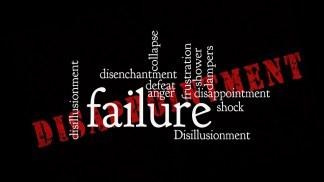 Refusal
RefusalRefusers deal with failure by denying a failure occurred at all. In their minds they won, but simply were denied the prize. Convinced that they did everything right, they believe they were indeed the “true” victor. They cannot take criticism and convince themselves that any differing opinions are invalid.
The lesson that must be learned: take self-importance down a peg. No one knows it all, and no one is so perfect there’s zero room for improvement. Look behind the mask, and ask the toughest question of all: Why is the need to always be right or to win so important? What fear does it hide?
Recommit
Recommitters represent the point of the knife. In that low moment, they take failing hard. They question their path. They may toy with quitting. But something sticks their feet to the road. The goal, the closeness of it, the realization of the hard work it took to get this far…something pulls them back from the brink. They marry the goal, and go all-in.
The lesson that must be learned: don’t give up. The hard part is done and now it’s about that last 10%. Push, strive, and believe. Keep learning and growing and it will happen.
Adapt
Adapters see failure as part of the process, so when they fail, they adapt. It isn’t the end of the world; there are other thing to want and go after. They move on.
The lesson that must be learned: find your passion and believe in yourself. Adapters may appear well-adjusted because they move on quickly, but this can also be a manifestation of a fear of risk. They may think it’s better to settle for what is safe than risk being denied what they really want. Settling usually leads to regret, so if you want something deeply, don’t give up on it.
Assess and Adjust
The double A’s move past failure in the healthiest way possible: they assess their performance, objectively review what they could have done better, and then they adjust, seeking out the help they need to improve and get to the next step.
The lesson that must be learned: there’s no lesson here…they’ve already learned it: you should never be afraid of growing and evolving, and asking for assistance if you need it.
Personalize
Personalizers take the failure to heart, and like the crumbly edge of a sinkhole, that darkness grows. Failing to achieve the goal becomes a spiral of falsehoods where a character convinces themselves that everything they touch is bad, that their life is one big failure.
The lesson that must be learned: your failure doesn’t define you, but your reaction to it might. Get some distance and perspective. Every day is new. Everyone fails and feels inadequate at times, but it is each person’s choice to make a change. Big or small, change happens because we will it, and we work toward it.
Wallow
Wallowers crumple. They become destroyed by failure, and are unable to move on from it or imagine feeling any different. They want others to cater to them, feel sorry for them, and jump through hoops to help pull them out of their funk.
The lesson that must be learned: wallowing isn’t attractive, and makes you weak. People may cater to you when you wallow, and this helps make you feel special, but this is just a patch on a leaky boat. You’ll never be happy if you let failure own you. Realize failure is really an opportunity to learn and grow. Embrace it, and resolve to do better next time.
So what are your thoughts on this? Do these lessons make sense? Do they help to reveal some of your character’s flaws, or give you ideas for emotional wounds? I hope so!
Failure is such an interesting topic, because no one likes failing and yet it is one of the building blocks that pushes a character find the resiliency to to keep trying, to fight…and that makes for compelling reading.
Which of these coping methods do your characters use? Or, do they handle failure in a different way? Let me know in the comments!
Image1 : Couselling @Pixabay
Image 2: Geralt @Pixabay
The post How Your Character’s Failures Can Map A Route To Self-Growth appeared first on WRITERS HELPING WRITERS™.
Writers Helping Writers
- Angela Ackerman's profile
- 1014 followers




